Vanuatu film screenings at GOMA to support Further Arts
Emyo Tinyo Dance and Music Festival 2014
Join us for a series of screenings which engage with the Ni Vanuatu dancers, villages and people that the Gallery have been working with over the past 18 months. Funds raised via the screenings will be directed through Further Arts. Further Arts is a community-based organisation that seeks to use art and culture for social transformation. The Gallery has been actively engaged with the organisation in the lead up to The 8th Asia Pacific Triennial of Contemporary Art (APT8), opening in November 2015.
‘The films we have chosen to show for this special event tell the story of the Ni Vanuatu dancers, villages and people that the Gallery has engaged with. Donations will be collected on the day and all monies raised will be used to assist Further Arts rebuild their Port Vila offices and the Emyotungan village, located on the remote island of Ambrym in central Vanuatu. The humble Further Arts headquarters were destroyed by Cyclone Pam earlier this month and this event is a simple gesture of support for an organisation that has inspired me,’ said Ruth McDougall, Curator, Pacific Art.
Emyo Tinyo, Ambrym
Ambrym, known for its active volcanoes and rich customs, is a remote island situated in central Vanuatu. Emyotungan village is located about 45 minutes walk inland and uphill from the West Ambrym coastline. The 50 or so inhabitants rely mainly on rainwater, local vegetation and agriculture to sustain their lives. In November 2014, this village, led by Chief Filip Talevu, hosted 11 dancers and musicians from across Melanesia as they engaged in a series of music and dance workshops to exchange contemporary and traditional beats and movements. This short film documents these workshops which form part of the APT8 project Yumi Danis (We Dance).
Lon Marum
Clips from Lon Marum – a documentary film depicting the relationship between language, culture, place, music, tradition and magic – in the context of life of an active volcano. Lon Marum was preselected for the 2014 Universite de Lorraine Festival du Film de Chercheur
Vanuatu Women’s Water Music
Selected clips from music video of the Vanuatu Women’s Water Music. This group hails from the remote northern tropical islands of Vanuatu. The beautiful video chronicles the activities of the Leweton women, their music and their community. The Vanuatu Women’s Water Music DVD was recently awarded 5 stars by leading World Music magazine Songlines.
Below, Ruth McDougall from QAGOMA and Roselyn Tari from Further Arts, write about their recent experience in the region.

Simane Wénethem, Emyo Tinyo Dance and Music Festival, Ambrym, 2014 / View full image
Yumi Danis (We Dance) | Ruth McDougall
Yumi Danis (We Dance) is a multi-art project incorporating visual arts, performance and dance from Melanesia developed especially as part of the Pacific representation for the upcoming The 8th Asia Pacific Triennial of Contemporary Art (APT8).
The project emerges out of stories about Melanesia told by ni-Vanuatu musician and author Marcel Meltherorong. Speaking of this region Meltherorong poetically describes mythical and historical connections between islands and the ways in which these connections have for centuries been communicated via dance and song. He also asserts the importance of the continued exchange of dance and other art forms, for the contemporary peoples of the Torres Strait, West Papua, Papua New Guinea, Solomon Islands, Fiji, Vanuatu and New Caledonia/ Kanaky.
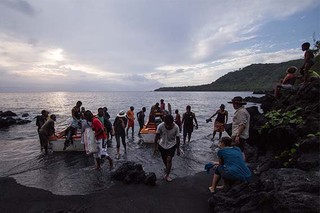
Yumi Danis participants arriving Craigs Cove, Ambrym, 2014 / Photograph courtesy Sarah Doyle, Further Arts, Port Vila / View full image
Inspired by this, a key component of Yumi Danis (We Dance) involved the Gallery selecting 11 dancers from across the region to participate in a workshop/ exchange hosted by the NGO Further Arts as part of the Emyo Tinyo festival in Ambrym, Vanuatu in November 2014. Further Arts is a charitable association based in Port Vila which seeks to further Vanuatu music, media, dance and culture. The organisation plays a vital role in providing opportunities to young men and women as well as remote communities seeking to develop cultural opportunities and festivals. The Yumi Danis (We Dance) participants travelled to Ambrym for ten days as part of the Ambrym festival to share dances from West Papua, Papua New Guinea, Solomon Islands, Fiji, Vanuatu and New Caledonia.
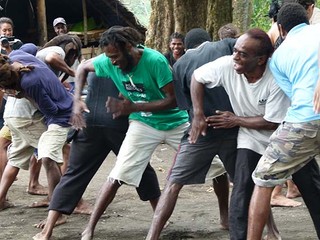
Yumi Danis participants dancing Solomon Islands dance, Emyotungan, Ambrym, 2014 / View full image
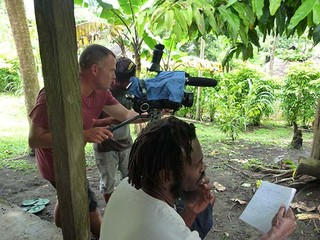
Interviews of Yumi Danis participants, Nicky, Ben and Marcel, Emyotungan, Ambrym, 2014 / View full image
The workshop was also attended by Kanaky visual artist Nicolas Molé. Performances, interviews and exchanges occurring during the workshop were documented by QAGOMA and young Further Arts photographers and filmakers, and this material will form part of a multi-media installation created by Molé, in collaboration with Meltherorong, for APT8.
Ruth McDougall | Curator, Pacific Art
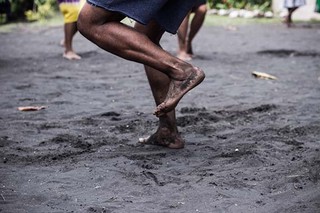
Dancing on black ash ground of Emyotungan village, Ambrym, 2014 / Photograph courtesy of Sarah Doyle, Further Arts, Port Vila / View full image
Exchanging kastom and culture through filmmaking at Emyo Tinyo Dance & Music Festival in Vanuatu | Roselyn Tari
What an incredible experience we all had in the island village of Emyotungan for the Emyo Tinyo Dance & Music Festival in November last year! I am especially grateful to have participated in this event through Further Arts TEKS (Traditional Entertainment & Kastom Support) Program as leader of the local film crew. It was a great opportunity for us to put our filming skills to work, and we were lucky to have the presence of a professional cameraman there too, Ben Wickes, from the Queensland Art Gallery.
Each day we worked together to film and photograph the intensive dance and music workshops. We used different filming techniques such as wide views, close ups, filming from above and below, and panning to create interesting shots that would be able to give the viewer a feeling of being there and experiencing the energy of the moment.
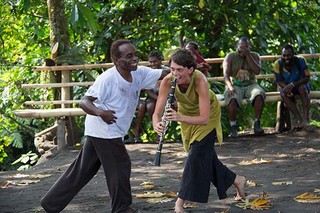
Musicians and dancers during the workshops / Photograph courtesy of Sarah Doyle, Further Arts, Port Vila / View full image
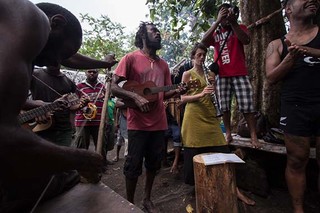
A mix of talented Melanesian musicians and dancers performing at the festival / Photograph courtesy of Sarah Doyle, Further Arts, Port Vila / View full image
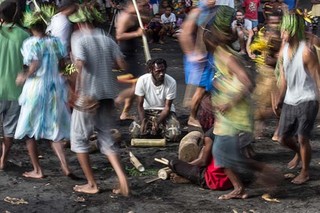
Marcel Meltherorong, Yumi Danis participants as part of Emyo Tinyo Music and Dance Festival, Emyotungan, Ambrym, 2014 / Photograph courtesy of Sarah Doyle, Further Arts / View full image
Additionally, the event was, for me, a chance to learn about and encounter different customs and cultures from my brothers and sisters that came from the Melanesian countries, Solomon islands, West Papua, Kanaky, Papua New Guinea, Fiji, and of course, Vanuatu. I discovered the unique creativity of our region through the songs, sounds and movements exchanged, and I also learnt about the meanings and stories behind them. This cross-cultural experience helped me to remember to be humble, finding a way to work with and alongside the local community. I also saw how we, as Melanesians, connect – this connection is why we can easily socialize when we come together, through a genuine feeling of family and solidarity.
Roselyn Tari | Further Arts Nesar Studio, writes about the experience of this event from the perspective of a young ni-Vanuatu photographer and filmmaker / Translation | Sarah Doyle

